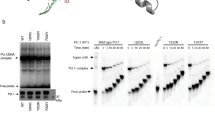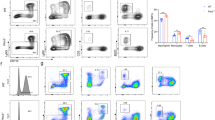Abstract
Promyelocytic leukemia (PML) is a nuclear protein that functions as a regulator of transcription, cell proliferation, apoptosis and myeloid cell differentiation. PML is subjected to post-translational modifications such as sumoylation and phosphorylation. However, the physiological significance of these modifications, especially for myeloid cell differentiation, remains unclear. In this report, we found that four serine residues in the PML C-terminal region are highly phosphorylated in a myeloid cell line. Wild-type PML accelerated G-CSF-induced granulocytic differentiation, but a phosphorylation-deficient PML mutant failed. PML interacted with C/EBPɛ, a transcription factor essential for granulopoiesis, activated C/EBPɛ-mediated transcription in concert with p300 and accelerated C/EBPɛ-induced granulocytic differentiation. Phosphorylation of PML was required for stimulating C/EBPɛ-dependent transcription and accelerating C/EBPɛ-induced granulocytic differentiation. We also found that PML phosphorylation was required for stimulation of PU.1-dependent transcription and acceleration of PU.1-induced granulocytic differentiation. These results suggest that phosphorylation plays essential roles in the regulation of PML to accelerate granulocytic differentiation through multiple pathways.
This is a preview of subscription content, access via your institution
Access options
Subscribe to this journal
Receive 12 print issues and online access
$259.00 per year
only $21.58 per issue
Buy this article
- Purchase on Springer Link
- Instant access to full article PDF
Prices may be subject to local taxes which are calculated during checkout





Similar content being viewed by others
References
Zhong S, Salomoni P, Pandolfi PP . The transcriptional role of PML and the nuclear body. Nat Cell Biol 2000; 2: E85–E90.
de The H, Chomienne C, Lanotte M, Degos L, Dejean A . The t(15;17) translocation of acute promyelocytic leukaemia fuses the retinoic acid receptor alpha gene to a novel transcribed locus. Nature 1990; 347: 558–561.
Wang ZG, Delva L, Gaboli M, Rivi R, Giorgio M, Cordon-Cardo C et al. Role of PML in cell growth and the retinoic acid pathway. Science 1998; 279: 1547–1551.
Kastner P, Lawrence HJ, Waltzinger C, Ghyselinck NB, Chambon P, Chan S . Positive and negative regulation of granulopoiesis by endogenous RARalpha. Blood 2001; 97: 1314–1320.
Muller S, Matunis MJ, Dejean A . Conjugation with the ubiquitin-related modifier SUMO-1 regulates the partitioning of PML within the nucleus. EMBO J 1998; 17: 61–70.
Bernardi R, Scaglioni PP, Bergmann S, Horn HF, Vousden KH, Pandolfi PP . PML regulates p53 stability by sequestering Mdm2 to the nucleolus. Nat Cell Biol 2004; 6: 665–672.
Yang S, Kuo C, Bisi JE, Kim MK . PML-dependent apoptosis after DNA damage is regulated by the checkpoint kinase hCds1/Chk2. Nat Cell Biol 2002; 4: 865–870.
Hayakawa F, Privalsky ML . Phosphorylation of PML by mitogen-activated protein kinases plays a key role in arsenic trioxide-mediated apoptosis. Cancer Cell 2004; 5: 389–401.
Scaglioni PP, Yung TM, Cai LF, Erdjument-Bromage H, Kaufman AJ, Singh B et al. A CK2-dependent mechanism for degradation of the PML tumor suppressor. Cell 2006; 126: 269–283.
Nguyen LA, Pandolfi PP, Aikawa Y, Tagata Y, Ohki M, Kitabayashi I . Physical and functional link of the leukemia-associated factors AML1 and PML. Blood 2005; 105: 292–300.
Lekstrom-Himes JA . The role of C/EBPɛin the terminal stages of granulocyte differentiation. Stem Cells 2001; 19: 125–133.
Fisher RC, Scott EW . Role of PU.1 in hematopoiesis. Stem Cells 1998; 16: 25–37.
Yoshida H, Ichikawa H, Tagata Y, Katsumoto T, Ohnishi K, Akao Y et al. PML-RARA inhibits PML IV enhancement of PU.1-induced C/EBPɛ expression in myeloid differentiation. Mol Cell Biol 2007; 16: 5819–5834.
Kinashi T, Lee K, Ogawa M, Tohyama K, Tashiro K, Fukunaga R et al. Premature expression of the macrophage colony-stimulating factor receptor on a multipotential stem cell line does not alter differentiation lineages controlled by stromal cells used for coculture. J Exp Med 1991; 173: 1267–1279.
Shimizu K, Kitabayashi I, Kamada N, Abe T, Maseki N, Suzukawa K et al. AML1-MTG8 leukemic protein induces the expression of granulocyte colony-stimulating factor (G-CSF) receptor through the up-regulation of CCAAT/enhancer binding protein epsilon. Blood 2000; 96: 288–296.
Kakizuka A, Miller Jr WH, Umesono K, Warrell Jr RP, Frankel SR, Murty VV et al. Chromosomal translocation t(15;17) in human acute promyelocytic leukemia fuses RAR alpha with a novel putative transcription factor, PML. Cell 1991; 66: 663–674.
Nakajima H, Ihle JN . Granulocyte colony-stimulating factor regulates myeloid differentiation through CCAAT/enhancer-binding protein epsilon. Blood 2001; 98: 897–905.
Verbeek W, Lekstrom-Himes J, Park DJ, Dang PM, Vuong PT, Kawano S et al. Myeloid transcription factor C/EBPɛ is involved in the positive regulation of lactoferrin gene expression in neutrophils. Blood 1999; 94: 3141–3150.
Engelhardt OG, Boutell C, Orr A, Ullrich E, Haller O, Everett RD . The homeodomain-interacting kinase PKM (HIPK-2) modifies ND10 through both its kinase domain and a SUMO-1 interaction motif and alters the posttranslational modification of PML. Exp Cell Res 2003; 283: 36–50.
Aikawa Y, Nguyen LA, Isono K, Takakura N, Tagata Y, Schmitz ML et al. Roles of HIPK1 and HIPK2 in AML1- and p300-dependent transcription, hematopoiesis and blood vessel formation. EMBO J 2006; 25: 3955–3965.
Acknowledgements
We thank Ms Yukiko Aikawa and Noriko Aikawa (National Cancer Center Research Institute) for technical assistance. This research was supported in part by a grant-in-aid from the Ministry of Education, Culture, Sports, Science and Technology of Japan, and by a grant from the Leukemia Study Group of the Ministry of Health, Labour and Welfare of Japan.
Author information
Authors and Affiliations
Corresponding author
Additional information
Supplementary Information accompanies the paper on the Leukemia website (http://www.nature.com/leu)
Rights and permissions
About this article
Cite this article
Tagata, Y., Yoshida, H., Nguyen, L. et al. Phosphorylation of PML is essential for activation of C/EBPɛ and PU.1 to accelerate granulocytic differentiation. Leukemia 22, 273–280 (2008). https://doi.org/10.1038/sj.leu.2405024
Received:
Revised:
Accepted:
Published:
Issue Date:
DOI: https://doi.org/10.1038/sj.leu.2405024



